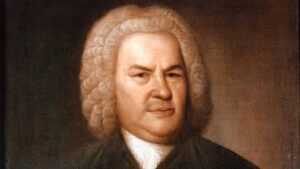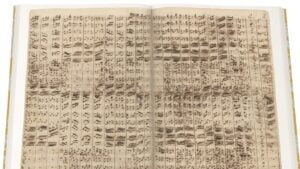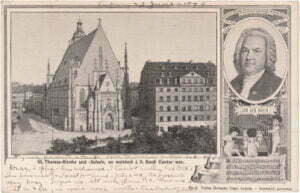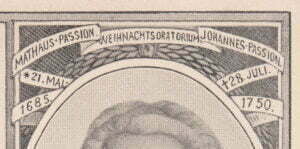- Johann Sebastian Bach – Eine Chronologie
- Wie der Vater, so die Söhne
- Bach-Repertorium
- Ist der Geburtstag von Bach am 21. März? 1685
- Herunterladen Sie die besten klassischen Noten herunter – download the best classical sheet music.
- The Best of Bach
- Johann Sebastian Bach
Johann Sebastian Bach (1685-1750) – A chronology
1685
Johann Sebastian Bach is born in Eisenach on March 21st. Many impressions and experiences from his childhood in Eisenach accompanied Bach throughout his life: the parental home that served as the town whistling house, the traditional Latin school with its student choir in the old Dominican monastery, the Georgenkirche with its organ, the town hall with the horns.

1693–1695
Attended the Latin school in Eisenach.
1694
J. S. Bach’s mother Elisabeth dies in May.
1695
Death of the father Johann Ambrosius Bach on February 20th. After the death of his parents, J. S. Bach came to Ohrdruf and lived in the house of his brother Johann Christoph, who was 14 years older than him and was the organist at St. Michael’s Church. Together with his brother Johann Jakob and his cousin Johann Ernst, he attended the Latin school, a very respected educational institution in the Duchy of Saxony-Gotha at the time. He sings in the school choir, whose duties include performances at Schloss Ehrenstein in Ohrdruf and singing chants.
Under the guidance of Johann Christoph he learned to play the organ. During this time, the organ of St. Michael’s Church will be thoroughly overhauled and repaired. The young Johann Sebastian probably learned the basics of organ building here. He dedicated a piano composition (Capriccio in E major, 1704) to his older brother. The home of the three Bach brothers falls victim to a major fire in 1753.
Browse in the Library:
Or browse in the categories menus & download the Library Catalog PDF:
1700–1702
J. S. Bach becomes a choirboy at the Michaelisschule in Lüneburg and a student of Georg Böhm. Visits to Johann Adam Reincken in Hamburg. He deals intensively with the North German organ tradition.
For a long time, one could only speculate about the musical abilities of the young Bach – the number of meaningful sources about the composer’s childhood and youth was too small. In 2006, however, copies of North German organ works were found in the Anna Amalia Library in Weimar, which turned out to be the earliest surviving Bach manuscripts of all.
The evaluation of the spectacular find has now put some aspects of Bach’s biography in a new light: Contrary to what is often assumed, Bach must have already had an extraordinarily high musical and technical standard at the age of about 13, because among the copies found in Weimar, which he made as a student in Lüneburg and Ohrdruf contain two of the most demanding organ works of his time. In addition, the find provides important information about a personal relationship between Bach and the Lüneburg organist Georg Böhm (1661–1733), which is always suspected but cannot be proven.
The paper used by Bach for his copies comes from Böhm’s possession, so the young Bach was probably even a student or journeyman of the important Lüneburg organist and composer during his training at the Michaelis School.
1702
J. S. Bach successfully applied for the position of organist in Sangerhausen. However, the personal intervention of the sovereign leads to the preference of another candidate.
1703
J. S. Bach becomes violinist in the private chapel of Duke Johann Ernst III for about half a year. In Weimar, is possibly the assistant to the court organist, Johann Effler.
In July, he comes to Arnstadt to test the new organ by Johann Friedrich Wender in the New Church (today the Bach Church). Later he gets a job as organist at the New Church.
Between 1620 and 1792 many members of the Bach family of musicians lived and worked in Arnstadt. A total of 17 family members were born here, eight married and 25 buried.
1705/1706
Stays with Dietrich Buxtehude in Lübeck for several months. Bach arbitrarily extended his vacation for this stay and received a sharp reprimand from his employer. He makes the journey on foot.

1707
In June, Bach took up the post of organist at the Divi Blasii Church in Mühlhausen. On October 17th he married his cousin Maria Barbara in the church in Dornheim (near Arnstadt).
1708
In February, the council change cantata »Gott ist mein König« (BWV 71) is ceremonially performed. It is one of the few pieces to be printed during Bach’s lifetime. In the years that followed, Bach received further commissions to compose the Mühlhausen council change, which can be interpreted as a reference to ongoing good relations in the imperial city.
The organ of the Divi Blasii Church was reconstructed in the 1950s at the suggestion of Albert Schweitzer, according to the disposition designed by Bach in 1708.
In June, J. S. Bach was appointed chamber musician and organist at the court of Dukes Wilhelm Ernst and Ernst August of Saxony-Weimar. He worked here until 1717 and composed numerous works for organ and harpsichord, as well as more than thirty cantatas. His most important place of work, the Castle Church, fell victim to a fire in 1774.
1709
Personal contact with Georg Philipp Telemann, exchange of compositions and sheet music.
References to a personal acquaintance between Bach and his colleague Telemann, who worked in nearby Eisenach, can already be found in the correspondence between Bach’s son Carl Philipp Emanuel and the Göttingen scholar and first Bach biographer Johann Nikolaus Forkel. For a long time, however, the search for original documents that could prove a meeting of the two composers during Bach’s Weimar creative period was unsuccessful.
Finally, in the 1980s, copies of a Telemann violin concerto were found that were clearly penned by J. S. Bach. How close the relationship between Bach and Telemann was is shown, not least by the fact that Telemann, who was already working in Frankfurt at the time, was the godfather of Carl Philipp Emanuel Bach’s baptism in 1714.
1710
The eldest son, Wilhelm Friedemann, is born on November 22nd.
1713
J. S. Bach travels to Weißenfels. This is where his first secular cantata, »What pleases me, is only the merry hunt« (BWV 208) for the birthday of Prince Christian zu Sachsen-Weißenfels, is performed. A few years later, this performance was followed by further guest concerts at the Weißenfelser Hof, which at the time was valued far beyond its borders for the high quality of its musical performances.
Finally, in 1729, the Weißenfels prince appointed Bach to the position of High Prince of Saxony-Weißenfels Kapellmeister – an office that he held »from home«, i.e. without having to give up his residence.
In December, Bach successfully completed an audition for the position of music director in Halle/Saale. However, he declines the post.
1714
J. S. Bach is promoted to concertmaster. Associated with this is the obligation to compose new pieces every month.
Son Carl Philipp Emanuel is born on March 8th. One of the godparents is Georg Philipp Telemann.
1715
Johann Gottfried Bernhard Bach is born on May 11th. He also later became a musician, but no compositions have survived.
1717
In August, Bach signs his contract as court music director to Prince Leopold of Anhalt-Köthen – without, however, asking for his release in Weimar beforehand. When he wants to make up for this, he does not receive his resignation and is imprisoned for one month for disobedience.
In December, he was released from prison and from his employment relationship with “disgraced” and took up the post in Köthen. In the same month he travels to his future place of work in Leipzig for an organ examination in the Paulinerkirche.
1720
When Bach returns from a trip to Karlsbad, to which he accompanied the prince, he learns of the death of his wife Maria Barbara, who died after a short illness and is already buried. Nothing is known about the exact cause of death.
In autumn, Bach travels to Hamburg for an audition.
1721
On December 3, Bach married the court singer Anna Magdalena Wilcke. Just a few days later, Prince Leopold married Princess Friederica Henrietta of Anhalt-Bernburg. She may be responsible for Leopold’s waning interest in music during this period. From 1722 Bach therefore looked around for new posts.
1723
In February Bach completed the rehearsal for the position of Thomaskantor in Leipzig. Already in the previous year, after the death of Johann Kuhnau, Georg Philipp Telemann was chosen as his successor.
However, Telemann stayed in Hamburg because of better earnings.
In the second round, Johann Christoph Graupner, Kapellmeister in Darmstadt at the time, was appointed first. Since he did not receive approval from his employer, J. S. Bach became the new Thomaskantor and ‘director musices’ in Leipzig with effect from June 1st.
Bach’s relationship with his previous employer, Prince Leopold, remains unaffected. Even after his departure from Köthen, Bach was allowed to continue to use the title ‘Kapellmeister’ and was commissioned every year to compose a celebratory cantata for the prince’s birthday.
Bach’s official duties as Thomaskantor include the weekly performance of cantatas for Sunday and festive services.
About 60 cantatas are needed per church year; According to information from his son Carl Philipp Emanuel, Bach is said to have composed a total of five such cantatas, but only just under three have survived. Almost all of Bach’s first Leipzig cantatas have survived, but the authors of the cantatas are largely unknown. Apart from a few recourse to older compositions from the Weimar period, the cantatas of the first Leipzig year are new compositions.
It is true that Bach can fall back on the help of older Thomaners both in rehearsals and in the time-consuming handwritten copying of the parts; the amount of work to be done for the weekly production of cantatas must still have been immense.

1724
Beginning of the disputes with the Leipzig University Music Director Johann Gottlieb Görner about the division of powers in music in the Paulinerkirche.
The Johannes Passion (BWV 245) will be performed for the first time on April 7th.
The 20-year fruitful collaboration with the lyricist Christian Friedrich Henrici alias Picander begins.
The 2nd Leipzig cantatas are born (“Choral Cantatas”)
With this series of cantatas, Bach takes up a technique that Johann Schelle, one of his predecessors in the Thomaskantorate, had already used: a well-known evangelical hymn is chosen as the basis for the cantata, which is artistically worked out in the opening chorale and is used unchanged in the closing chorale, in the intermediate parts but undergoes decisive musical and textual changes.
The contents of the middle stanzas are rewritten in aria and recitative form, thus linking the old tradition of the chorale cantata with the modern cantata form based on Italian opera. Bach’s consistent adherence to this principle forbade recourse to older material – the cantatas of the second Leipzig year are therefore almost exclusively new compositions.
1725–1727
The 3rd year of cantatas comes into being.
1727
On April 11, the Matthew Passion (BWV 244, 1st version) will be performed for the first time.
1729
From March Bach will take over the Schott’sche Collegium Musicum
At the beginning of the 18th century, parallel to church and court musical life, a flourishing bourgeois concert business was established in almost all European music centres.
One of the most important institutions of the early bourgeois music cultivation are the Collegia Musica – ensembles, which consisted mainly of amateur musicians and regularly organized private and public concerts.
The Collegium Musicum, taken over by Bach in 1729, had previously been under the resigning New Church organist Georg Balthasar Schott. It found its home in Gottfried Zimmermann’s bar, the operator of one of the largest and most popular coffee houses in Leipzig. It was here that rehearsals and weekly concerts took place, and in the summer months there were open-air performances.
In addition to works by contemporary composers, Bach presented numerous compositions of his own, including the orchestral suites (BWV 1066-68), the violin and harpsichord concertos (BWV 1041-1043 and BWV 1052-58). Special concerts were also organized for special occasions such as birthdays and name days, for which Bach contributed numerous secular cantatas. Bach composed his famous »Coffee Cantata« (BWV 211), a clear allusion to the residency of the Collegium, for such an »extraordinaire« concert.
The work with the Collegium Musicum for Bach’s piano compositions was of particular importance: since moving to Köthen in 1717, Bach had not pursued any official activity as an organist, and so the concerts in the Zimmermannsche Kaffeehaus offered a welcome opportunity to establish himself in Leipzig not only as a cantor and music director, but also as a keyboard virtuoso.
Bach was also able to benefit from the Collegium Musicum in his position as Thomaskantor, because here he found capable temporary musicians for performances with a larger cast, which he would not have been able to accomplish with the St. Thomas Orchestra alone.
1730
Bach writes the ten-page submission ‘Short but highly necessary draft of a well-ordered church music’, which is intended to persuade the city council to provide him with sufficient funds for the choir and orchestra.
1731
On March 23, the St. Mark Passion (BWV 247) will be performed for the first time.
1732
Johann Christoph Friedrich Bach is born on June 21st.
1733
Bach presents the Kyrie and the Gloria of the Mass in B minor (BWV 232 I-II) to the new Saxon Elector Friedrich August II in Dresden – combined with the hope of the prestigious title of Saxon court composer or Kapellmeister.
1734–1735
From December 25th to January 6th the six parts of the Christmas Oratorio (BWV 248) will be performed for the first time.
1735
Johann Christian Bach is born on September 5th.
1736
A dispute breaks out between Bach and the rector of the Thomas School, Johann August Ernesti, about the authority to appoint choir prefects (“prefect dispute”).
In November, after repeated requests, Bach was appointed court composer to the Electoral Saxon and Royal Polish Court. This also strengthens its own position in the dispute over competences with the Leipzig authorities.
1741
Bach travels to Berlin for the first time. On the occasion of the wedding of the doctor Georg Ernst von Stahl, the cantata ‘O holder Tag, Wunsche Zeit’ (BWV 210) is performed there.
For a long time, hardly anything was known about the genesis of this work, only the date of origin could be narrowed down to the period between 1738 and 1741. The recipient of the congratulatory cantata was sought among Bach’s patrons in Leipzig, but no concrete information was forthcoming.
A few years ago, a personality who had not previously been considered as a possible recipient of the cantata finally entered the music-historical arena: the Berlin personal physician and privy councilor Georg Ernst von Stahl, who until then was less a patron of Bach himself and more a friend and supporter of his sons Wilhelm Friedemann and Carl Philipp Emanuel was traded.
In an auction catalog listing the estate of the Prussian personal physician and music lover, one found not only numerous pieces of music but also the vaguely specific reference to »A cantata by Johann Sebastian Bach«. As is usual in auctions, a lot number is noted next to this entry – the number 5.
In fact, in 2000, when looking through the relevant sheet music for this »cantata«, a hit could be landed: on the original set of parts of the wedding cantata »O holder Tag, Wunsche Zeit« there is a small number that was added in ink afterwards – the ticket number 5.
The biographical data provide indications that the Berlin doctor should actually be considered as the recipient of the composition: During his first trip to Berlin in August 1741, Bach was a guest at Stahl’s house, and only a month later the latter celebrated his wedding for which he could well have commissioned a festive cantata from Bach.
This suspicion is finally confirmed by a passage in the cantata itself: »In many places / Your well-deserved praise will resound. / Your fame will be like a diamond, / Yes, like solid steel, / Until it resounds throughout the world.”
So far, no meaning has been attached to this crooked metaphor – steel is by no means harder than diamond, as the poetry tries to suggest here. Against the background of the findings described, however, it now appears in a new light – as a hidden allusion to the recipient of the cantata.
1747
In May J. S. Bach visits Friedrich II in Potsdam and Berlin. It was the only time Bach was mentioned on the front page of a newspaper: an unknown editor of the ‘Berlinische Nachrichten’ reported on Bach’s arrival in the evening, on being greeted by the king, on playing the ‘so-called forte and piano’. and finally the king’s task that Bach improvise a given theme into a fugue off-the-cuff – a great moment in music history, which resulted in the famous »Musical Offering«.
1748
Completion of the Mass in B minor (missa tota, BWV 232).
1749
Bach’s health deteriorated, he suffered from a serious eye condition and also had motor problems in his right arm, his writing hand.
1750
J. S. Bach undergoes an eye operation by the famous, but even then controversial ophthalmologist Sir John Taylor, who stayed in Leipzig from April 4th to 7th, 1750. Complications require reoperation. Bach can see again for a short time, but a few days before his death he suffers a stroke.
Johann Sebastian Bach died on July 28, 1750.
Wie der Vater, so die Söhne
The genealogy of the ‘musical-Bach family’ compiled by Johann Sebastian Bach around 1735 based on older sources lists 53 musicians by name. In the meantime, a good 80 people have been recorded who worked as composers, musicians and, in some cases, as visual artists from the 16th century until the death of Bach’s grandson Wilhelm Friedrich Ernst in 1845.
Numerous compositions by individual members of the older Bach family have survived; further evidence can be found on the basis of inventories and other documents – sources that have so far only been selectively evaluated by local historians. Four of Johann Sebastian Bach’s sons worked as professional musicians, two more could not fully develop their musical talents.
All of his five sons who reach adulthood follow in their father’s musical footsteps. Four of them surpassed Bach’s fame during his lifetime and are known to this day.
Wilhelm Friedemann Bach (1710-84) was organist in Dresden and Halle, Carl Philipp Emanuel (1714-88) became court musician at the Prussian royal court of Friedrich II and later cantor and music director at the Johanneum in Hamburg.
Johann Christoph Friedrich Bach (1732-95) became concert master at the Bückeburg court and Johann Christian Bach (1735-82) worked as a cathedral organist in Milan and as an opera composer in London..
Bach-Repertorium
The contribution of the Thuringian-Saxon family of musicians to European music history is without parallel. The task of the ‘Bach Repertory’ project is to index the verifiable musical works of all members of the widely ramified Bach family of musicians in the form of a ‘Catalogue raisonné’, to record the documents on the life and impact history of the family members and to present selected works in scientific editions .
The information collected will be available in both printed and online form.
‘Bach Repertory’ is a research project of the Saxon Academy of Sciences in Leipzig – located in the Bach Archive Leipzig – and is funded by the Packard Humanities Institute (Los Altos, California).
Contact person: Dr. Christine Blanken and Dr. Wolfram Ensslin.
Is Bach’s birthday on March 21st? 1685
On Johann Sebastian Bach’s day of honor: In some historical publications – or alternatively – March 21st is given as Bach’s birthday. However, this is the date of the (old) Julian calendar, which was still valid in Eisenach around 1750. According to our (Gregorian) calendar, that was March 31st.
Just so much in advance on this topic and a quick bit of background on the above explanation: whether Johann Sebastian Bach was born on March 21st or March 31st of the year 1685 is actually … completely irrelevant. But the explanation above – thanks to a Bach friend for the short formulation – would be exciting if we read here from mid-March, there from the end of March, when it comes to the birthday of this outstanding musician.
But of course, in many publications, that goes much too far. Imagine just an introduction and then an asterisk on the third word and all these clues. no Finally, there was agreement in Bach science – which does not include ‘Bach about Bach’. Exactly on March 21, 1685. And since it is not one of the most important secrets and information, we simply agree. And so we are ‘in line’ with Christoph Wolff, the outstanding Bach scholar of our time, the Bach Archive in Leipzig and the Bach House in Eisenach.
This is an antique postcard, certainly printed, described, sent, delivered, read in many 1,000 pieces…


… the birthday of Johann Sebastian Bach on March 21st, March 31st, May 21st … who really cares that much?!
Download the best classical sheet music – download the best classical sheet music.
The Best of Bach
Johann Sebastian Bach
1. Brandenburg Concerto No. 1 in F major, BWV 1046 Allegro (00:00) Adagio (4:43) Allegro (9:10) 2. Brandenburg Concerto No. 3 in G major, BWV 1048 Allegro (13:40) Allegro assai (19:11) Allegro (24:05) 3. Brandenburg Concerto No. 4 in G major, BWV 1049 Presto (31:42) Andante (36:37) Affettuoso (39:32) 4. Brandenburg Concerto No. 6 in B flat major, BWV 1051 Allegro (45:02) 5. Concerto for Violin and Oboe in C minor, BWV 1060 Allegro (50:38) Largo (54:59) Allegro (59:32)
6. Orchestral Suite No. 2 in B Minor, BWV 1067: Menuet (1:02:35) 7. Orchestral Suite No. 3 in D Major, BWV 1068: Air on the G String (1:05:35) 8. Cantata BWV 147: Jesu, Joy of Man’s Desiring (1:10:07) 9. Toccata and Fugue in D Minor, BWV 565 (1:13:32) 10. Harpsichord Invention No. 1 in C major, BWV 772 (1:22:23) 11. Harpsichord Invention No 8 in F major, BWV 779 (1:23:43)
12. Orchestral Suite No. 2 in B Minor, BWV 1067: Badinerie (1:24:42) 13. Notebook for Anna Magdalena Bach: Minuet in G major, BWV Ahn. 114 (1:27:24) 14. Notebook for Anna Magdalena Bach: Musette in D major, BWV Anh.126 (1:28:59) 15. Violin Partita No. 3 in E Major, BWV 1006: Bourée (1:30:06) 16. Sonata for Viola da Gamba & Harpsichord, BWV 1028 (1:31:48) 17. Concerto in D minor, BWV 1059: 2nd Movt. (1:35:44) 18. Cello Suite No. 4 in E-flat major, BWV 1010: Courante (1:38:54) 19. Cello Suite No. 6 in D major, BWV 1012: Gavotte (1:42:32) 20. Cello Suite No. 6 in D major BWV 1012: Prelude (1:46:42)
Bach, J.S. – Fifteen two-part Inventions (BWV 772-786) Noten – sheet music
Browse in the Library:
Or browse in the categories menus & download the Library Catalog PDF:
